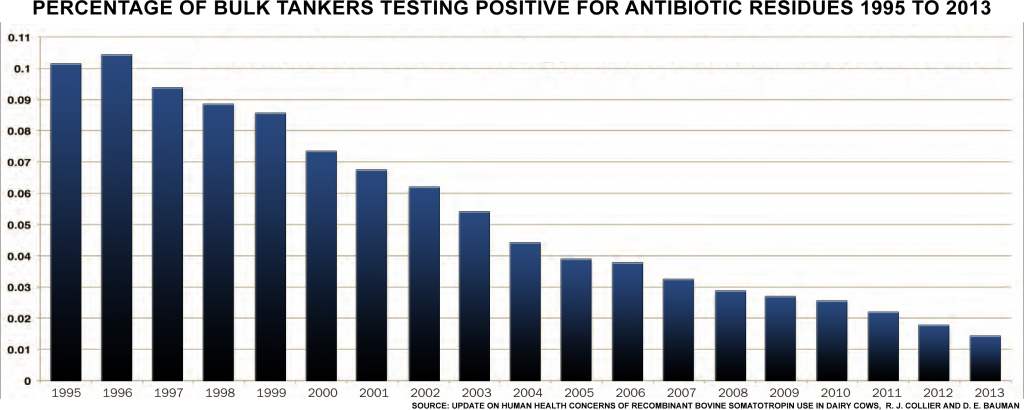Mark Twain once remarked, “Truth is mighty and will prevail. There is nothing the matter with this…except that it ain’t so.”
For more than 20 years articles supporting the truth about the safety of rBST have been stacking up but have had little impact on settling the debate. Critics are either unwilling or unable to accept two decades of findings regarding the safety of what a recent Hoard’s Dairyman article referred to as “the most studied product in the history of U.S. dairy farming.” All of which brings me to our love hate relationship with food and, most particularly, with health risks based on the use of rBST, GMOs and other modern livestock rearing practices.
Protests and Politics
The heated debate over so-called Frankenfoods is not only about the pros and cons of genetic manipulation to improve nutritional value and resistance to disease; it also concerns honesty vs lies, ethics vs deceit and fact vs fiction.
The trouble with trying to inform the misled or to defend those who would attack dairy producers, is that you always feel that you are perpetuating the drama. However, when the industry is under constant attack, it is necessary for everyone of us to take a stand. For those not inclined to active retaliation and the resulting frustrations, a less aggressive step might be as simple as sharing a well-written book. “The Frankenfood Myth” by Henry Miller and Gregory Conko takes a long, hard look at both the new agricultural biotechnology and the policy debate surrounding it. At some point, we must encourage all sides, including ourselves, to proactively encourage change.
From Panic to Prudence
It would be wonderful to declare categorically that all dairy farmers understand the science and nutrition of the products they produce and that everything is 100% safe. That would be wonderful but would it be true? There is no doubt that the technology is safe but are we accepting the responsibility for making sure the consumers whose purchasing power we depend on are as well-assured.
For one thing, before we ask the general public not to swallow the headlines from either side of this debate, we need to take a look at what is in our own glass and on our own plates. It doesn’t matter whether you are involved in dairy farming 24/7 or only connect with dairy products at mealtime , it’s impossible to ignore headlines that blame everything from early onset puberty to excessive obesity on hormones found in dairy products. These truths or lies and the resulting consequences have frightening implications for every food consumer. Of course, we all know that the easiest way to stir things up is to raise fears! Fear of hormones is much easier to focus on than taking responsibility for what is happening to our hearts and waistlines by our own hand. Once you have an enemy to blame for obesity, heart disease and cancer, you can protest that this enemy is responsible for our one way ticket to a hospital ward and continue to be oblivious to the dangers of the “drive through”, “fast food” and “heat it and eat it” convenience foods.
Early Puberty and Rampant Childhood Obesity. Who`s Responsibility is It?
Of course, farmers join all food consumers in having concerns about the potential problem of feeding hormones to our children. But let’s start with the known before we raise the unknown fears. A child’s body produces 50,000 nanograms of estrogen per day. A non-pregnant adult will produce 480,000 nanograms of estrogen daily. Furthermore, when hormones in food are eaten, they break down in the process of digestion and are largely neutralized. The following listing of the amounts of estrogen in common servings of food is not to disparage in any way the food source itself, but is given as facts to understand not fears to react to.
Beef 1.9 nanograms
Potatoes 225 nanograms
Peas 340 nanograms
Ice Cream 520 nanograms
Cabbage 2,000 nanograms
Soy Milk 11,250 nanograms
Soybean Oil 170,000 nanograms
The 1.9 nanograms of estrogen in implanted beef is also miniscule.
At some point, farmer or not, we have to step back and take responsibility for our own health and that of our children. Responsible dairy managers wouldn`t think of harming their calves and cows by feeding them a diet that would give them a body condition score of 5 (or at the other extreme -1). Restricting bovine diets because of unsupported fears overheard or read about is also rarely done on farms. In fact, there is extreme attention paid to balancing diets, providing minerals, proteins and nutrients that provide the energy needed for production and reproduction. When I was first married and a young mother myself, I often was amazed at how much careful attention was focused on the pregnant bovine and felt that human nutrition could benefit from the same careful consideration. Of course, as with most things we “discover”, the information has always been available, it is the implementation that is missing or ignored. Before we blame the farmer or accept unfounded fear-mongering, we have to use the same careful consideration on our family’s health that we apply to the dairy herd we care for.
That is part of the answer of where dairy products should fit into diets for youth. Unfortunately, more than we want an answer we sometimes want to avoid responsibility. When we are afraid it’s easy to point the finger at dairy farmers or, if we are one of those farmers, we yell back at the unreasonable name calling. Finding a guilty party lets us off the hook because we are not personally involved in food production and processing. However, we can only remain oblivious as long as we ignore the obvious. The obvious cause of obesity (on or off the farm) is a direct result of excess calories consumed and the resulting increased levels of body fat. “BMI (body mass index) is the biggest single factor for the onset of puberty.”
Which brings us back to fears laid at our dairy farming doorstep because the public is concerned about how their food is produced and, for today’s discussion, fears over the safety of rBST. They are not wrong in their concern. But we mustn’t sidestep our responsibility as dairy producers. It is our responsibility to provide the right information, in open and honest discussion. So let’s look at the facts that we can and should be sharing.
We Dairy Farmers Take Pride in the Progress Made in Providing Safe Healthy Food
- Recombinant bovine somatrotropin (BST) makes milk and money for producers who use it.
- rBST has been reviewed by the U.S. Food and Drug Administration(FDA) and by JECFA under the administration of the United Nations`Food and Agriculture Organization and the World Health Organization
- rBST has been approved in 1993, 1998 and will be reviewed again in 2016
- “Research has demonstrated that human somatrotropin increase immune system function in HIV infected people.”
- Overall, there is no evidence of increased expression of retroviruses in cattle treated with BST
- or that retroviruses in cattle would pose a risk to human health.”
Dairy farmers can take pride in the self-regulating they have done in providing ever-healthier milk products to consumers.
Somehow, in the modern media rush to condemn, we have lost sight of the basic principles of nutrition that we all know. Science supports the health benefits of the products dairy farms produce. “In 2010 the U.S. Department of Agriculture even identified dairy products as a major source of 3 of 5 nutrients of concern that are marginal or inadequate in childrens’ diets.” The other side of the equation is that healthy food must be provided for a dramatically increasing market of consumers. We must find efficient, productive and profitable ways to do so. Research and resources will focus on that goal. Progress is built on discovering and using safe, healthy technology such as that provided by rBST. We need to speak up in defence of our industry.
The Bullvine Bottom Line
rBST is safe. Does that mean our children, or even we ourselves, are consuming the best possible diets? Before we dig in to immovable positions on either side of that argument, we need to consider what we are digging into on our plates.
Achieving optimum health, like managing a productive dairy operation, is based on choices and, ultimately, we are all responsible for the choices we make. Make good ones.
Get original “Bullvine” content sent straight to your email inbox for free.



















Leave a Reply
You must be logged in to post a comment.